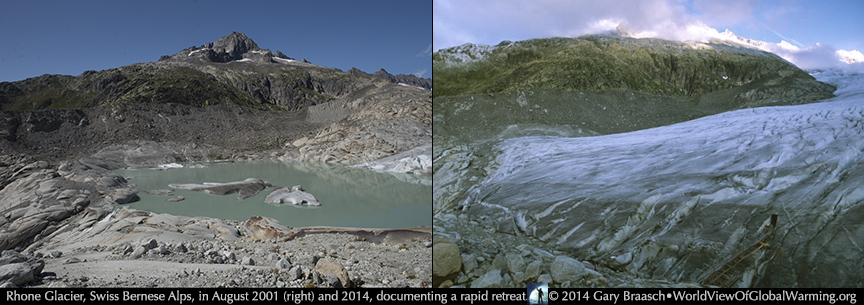NY Times cover story illustrates the dangers of oil drilling in the Arctic, and underscores need for limits on petroleum exploration in Alaska.
Climate Photo of the Week
Switzerland leads in climate pledges while its glaciers melt

As its glaciers melt, Switzerland leads nations in officially promising lower carbon emissions, bringing into focus the daunting work of powering civilization into a future without fossil fuels or wasteful energy and land use.
With its famous glaciers receding rapidly, Switzerland has become the first nation to formally promise its contribution to an international agreement to hold off disastrous climate change. It is a small start for this urgent process – Switzerland makes only one-tenth of one percent of world greenhouse emissions.
In the year-long preparation for an all-nation climate change treaty to be negotiated in Paris this fall, the United Nations has asked all countries to clearly pledge before October 1 how much they will reduce emissions in the coming decades. The UN will then estimate how close the pledges will come to averting the severe disruptions to natural processes that scientists say are coming if the world does not rapidly slow almost all emissions from fossil fuels and land use. The reductions promised will guide the Paris talks toward an agreement.
“Averting the severe disruptions” means keeping the earth average surface temperature below 3.6 degrees F (2 degrees C) warmer than it was before coal and oil began fueling the industrial revolution. Detailed reports issued by the scientists of the UN climate panel (IPCC) last year made it clear that keeping under this limit requires “substantial emissions reductions over the next few decades and near zero emissions of CO2 and other long-lived [greenhouse gases] by the end of the century.”
Near zero. Can the world change is such a short time so much of its power source, now 85 percent fossil fuels, the very power that brought civilization to this point of progress and peril? Detailed reports say, yes, and yes, and yes, it can be done, and with substantial improvements to health and well being for billions of people. These “healthy reductions” will be very hard to accomplish, given vast infrastructure and technical challenges and the bullheaded and well funded inertia of many industries and politicians.
Politics aside (which in the United States would be a great advancement), the near future can be seen in these reports and the currently working examples of clean renewable power and efficiencies. World View of Global Warming will be looking into this great challenge – and seeing the future today – in coming months this year.
(Note: For a semi-technical discussion why the “2 degree C” temperature limit is important and why it came to be accepted at the Cancun international climate talks in 2010, please see RealClimate.org)



